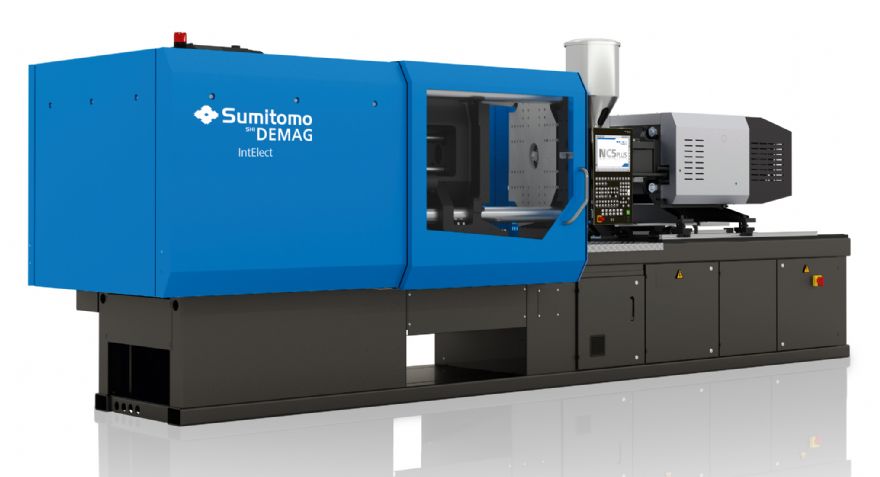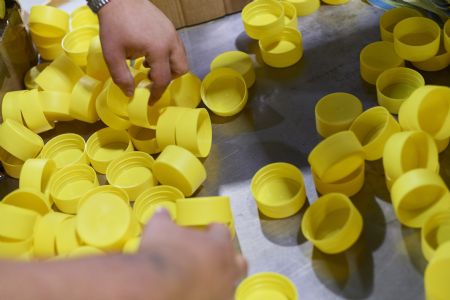
Consistency of process, huge cycle time and energy savings, reduced scrap rates and an enhanced working environment are some of the benefits reported by Kidlington-based
Essentra Components following a series of hydraulic versus all-electric like-for-like tests.
For these, the company put its new IntElect 50-tonne machine — from Stoke Mandville-based
Sumitomo (SHI) Demag Plastics Machinery UK Ltd — ‘through its paces’, trialling over 50 different applications and tools.
Chris Butler, Essentra’s divisional process development manager, said that performing tests against the same tonnage hydraulic machine of similar specification showed that the cycle times and energy savings achieved by the all-electric machine surpassed all his expectations.
“What we were expecting versus what we documented during the trials was exceptional,” said Mr Butler, who is in charge of a huge project to analyse the age, condition and sustainability of the company’s combined fleet of 419 moulding machines spread across 13 countries.”
In particular, he was interested in showing that the improvements realised by taking the all-electric route would enable Essentra to maintain its capacity while shrinking its machine count — and lowering the company’s overall carbon footprint without compromising output, cycle times or moulding quality.

The series of trials completed over the summer months of 2020 allowed Essentra to collate all the raw data it needed to push forward with its investment strategy of replacing ‘legacy’ hydraulic machines with all-electric types.
The trials revealed an average 24% cycle time saving, thanks to the IntElect’s improved process control, as well as a quicker clamp unit and faster linear movements. Indeed, Mr Butler calculated that across the company’s entire fleet they could potentially install, run and maintain 100 fewer injection moulding machines if replacing hydraulic with like-for-like all-electric machine.
“The capacity gains in a test for one particular job, of which we make 1.6 million parts annually, equated to saving 248 hours production a year. That is an exceptional saving.”
Saving powerIn a separate trial, Nick Stockton — Sumitomo (SHI) Demag’s technical manager — replicated the exact product processing, shot weight, cycle time and machine tonnage to document energy improvements. Previously, a hydraulic machine consumed 6.31kW at an average cost of £0.78/hr; on the new IntElect this dropped to 4.3kW — an instant 32% energy saving without adjusting any of the process steps.
Another IntElect attribute that impressed Essentra’s moulding team was the stability of the moulding process. When monitoring the entire sequence from mould open and close to injection time, screw position, melt cushion and injection pressure peak, zero deviations from cycle-to-cycle were consistently reported.
Mr Butler, who has worked in the moulding industry for more than 30 years around machines, added: “I was amazed. The IntElect consistently hits its injection time every single time consistently. That for me is world class manufacturing, and further strengthens the case for all-electric.
“In addition, the manual sorting and separation of sprues was always a labour intensive task that resulted in a lot of waste and was a health and safety risk for workers in the vicinity of the machine. Integrating a servo driven robotic system onto the 50-tonne IntElect has eliminated this manual process. Again, tests showed that manual checks resulted in over 9% of parts being lost; simple automation cuts this to just 0.01%.

“Our new robotic handling system funnels parts where they need to go and removes waste plastic on ejection. In a lot size of 250,000, the trial reported just 26 lost parts. Although we have robotics on other machines, this is our first fully integrated system. It has proven easy to use and the performance is exceptional.”
He continued: “On the basis of these tests, Kidlington is planning a full switch to all-electric over the next decade. Other divisions are also leveraging this valuable data to justify future machine replacements. With over 20,000 mould tools spread across the Essentra Components division, machine flexibility and program standardisation is vital. We regularly move tools and even the machines between our sites.
“Training is also key to achieving the highest level of processing consistency. We use Sumitomo (SHI) Demag for all of our training, and to date more than 40 team members from Kidlington have attended courses delivered by the Sumitomo (SHI) Demag Academy.
“The IntElect trial project was to determine whether an all-electric machine could deliver the capabilities and improvements needed to be more sustainable and shrink the company’s machine count long term. These trials have been extremely valuable and insightful. The energy and cycle time savings made have been nothing short of remarkable.”